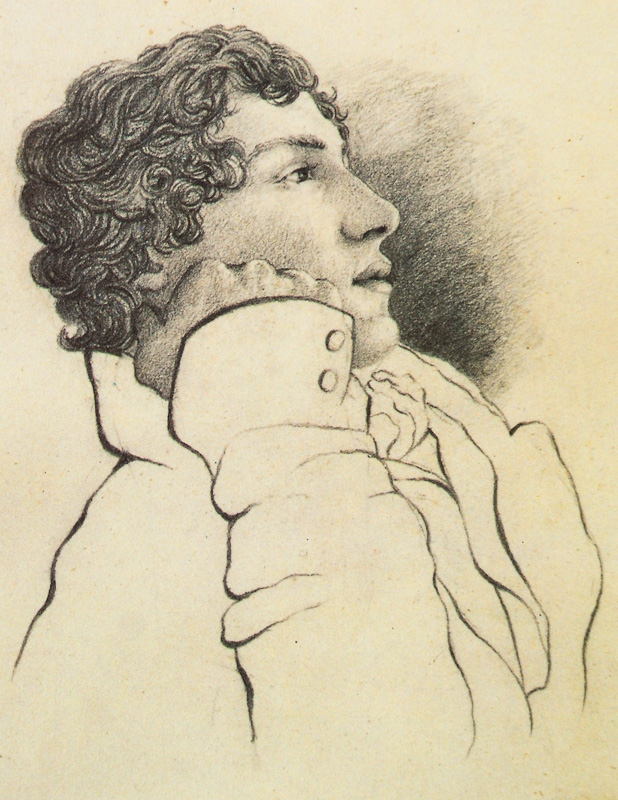John Keats (1795-1821).
Portrait by Charles Armitage Brown, 1819
* * * * *
John Keats was born in London on 31st October, 1795, the eldest of five children, one of whom died in infancy. The first few years of his life are obscure but it is known that at the time of his parents’ marriage his father was working at the Swan and Hoop, Moorgate – an inn and stables owned by Keats’ maternal grandfather.
In 1797, when his brother George was born, the family were living to the north of the City Road, and were still there in 1799 at the time of the birth of a third son, Tom. By 1803 Keats’ father had become manager of the inn, and the family, now including a daughter, Fanny, was living in Moorgate. In the same year Keats and George were sent as boarders to Clarke’s School, Enfield.
Keats’ father died in 1804 following a fall from a horse, and his mother in 1810 of consumption. A few months after his mother’s death the fourteen-year-old Keats began a five-year apprenticeship as a surgeon-apothecary in Edmonton, taking meals with his employer’s family and sleeping in an attic room over the surgery. His younger brother, George, became a clerk in the office of the man appointed as the children’s guardian. Tom, who was only ten, stayed on at school in Enfield for the time being, and Fanny was cared for in Edmonton by her grandmother. George, perhaps finding himself the loneliest of the four, seems to have lodged with his guardian in the City.
The ending of Keats’ apprenticeship coincided with the passing of an Act intended to ‘prevent any Person or Persons from practicing as an Apothecary without being properly qualified as such’, and in order to be able to apply for membership of the Royal College of Surgeons Keats undertook further studies at Guy’s Hospital. In the summer of 1816, at the age of twenty, he passed his Apothecary examinations, but by this time his attempts to combine a career as a doctor with his ambition to make his name as a poet were coming to an end.
His first collection of verse, Poems, was published in 1817 and was followed in 1818 by Endymion. In July 1920 he published his third and last volume, including many works for which he is now famous: ‘The Eve of St Agnes’, ‘Ode to a Nightingale’, ‘Ode on a Grecian Urn’, ‘La Belle Dame Sans Merci’, ‘Lamia’ and ‘To Autumn’.
By the Spring of 1820 Keats was suffering from consumption; the same disease which had killed his mother and his younger brother Tom, whom he had nursed through his final illness. On the advice of his doctors Keats left England in September, intending to spend the winter in Italy with his friend Joseph Severn. He no longer had any money of his own and was dependent on the support of his friends. He wrote no more poetry and died in a tiny apartment above the Spanish Steps in Rome on the 23 February, 1821. He was twenty-five years old.
Keats never gave up the idea that he might one day return to medicine. He kept his textbooks and advised his friends about their health, and at times his recurring financial difficulties led him to consider becoming a surgeon on a ship. Throughout his life he referred frequently to his wish ‘of doing the world some good’ and in much of his writing he combines his acceptance that suffering cannot be avoided with the proposal of an ideal role for the poet as creator/physician.
His reputation in some quarters as the epitome of the fragile and sickly Romantic poet is misleading: he was described by his headmaster at Clarke’s School as having ‘a highly pugnacious spirit’ and a fellow-pupil thought it likely that he would end up serving in ‘some military capacity’. Until the onset of his illness he was a person of tremendous energy, and although his great zest for living was overshadowed at times by moods of bitterness and mistrust this did not prevent him from making many close friends. His correspondence with them, and with his brother George, from whom he was separated after the latter’s emigration to America, provided a valuable means of exploring ideas about writing and many of the letters themselves include poems and vivid images which later became incorporated in his work.
Text © Angela Williams, 2010
LINKS
– Letters of John Keats to his Family and Friends, edited by Sidney Colvin
